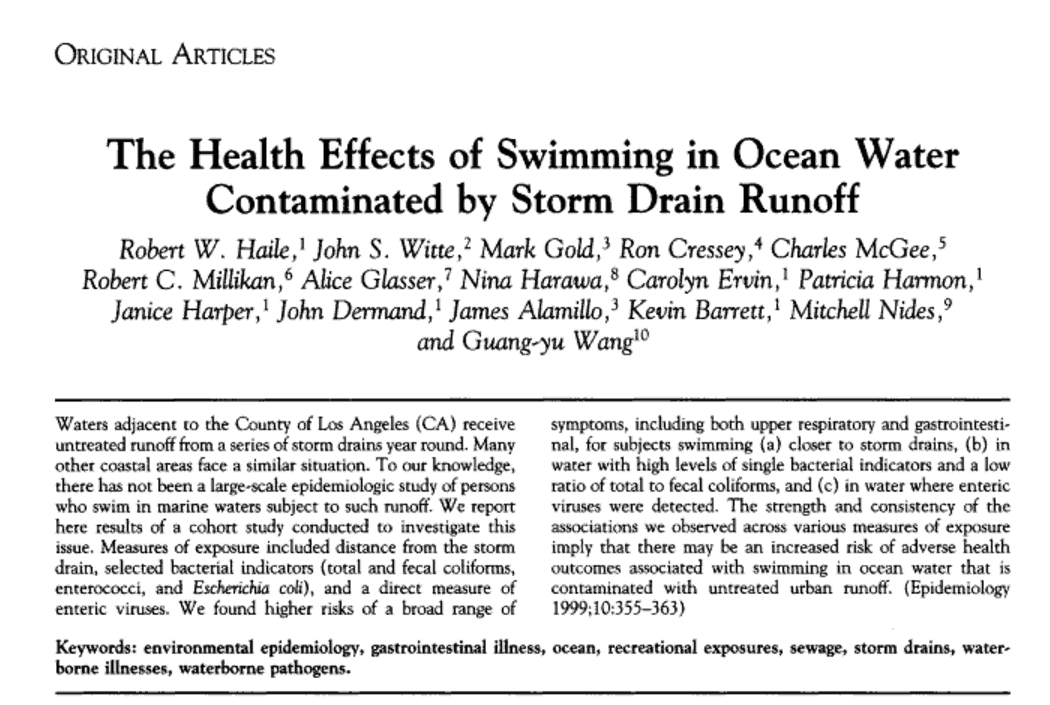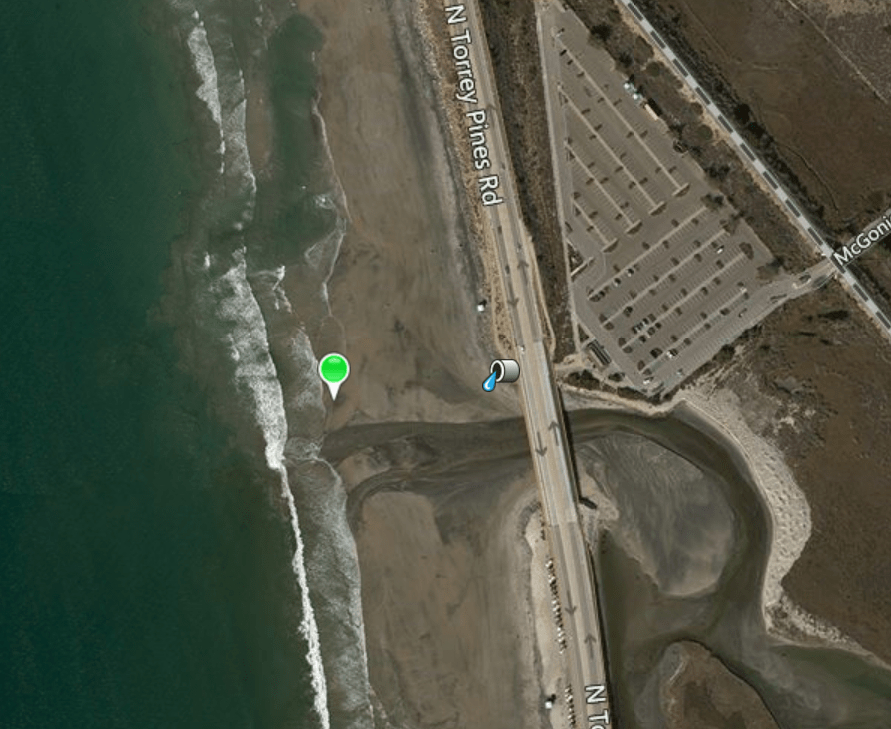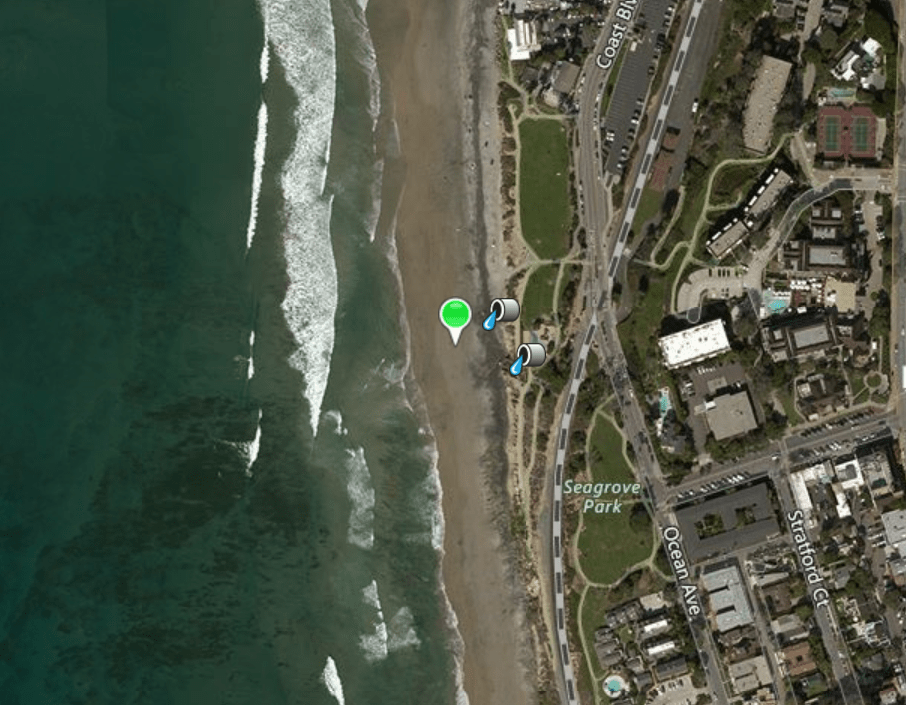The Darkside Of Del Mar Beaches – The Short Version First – Stay Out Of The Water When It Rains. (images down to Blacks Beach / La Jolla Shores included below)
Just so you don’t have to read much more, here is the rule of thumb: If it is raining or rained over the past few days, stay out of the water because all the ‘crud’ in our community such as trash, dog waste, lawn chemicals, car oil and more run down the San Dieguito River, flow out into the water near 15th Street as well as at Torrey Pines and Los Peñasquitos Lagoon area and empty into the ocean.
The San Diego County Department of Environmental Health advises the public to avoid contact with ocean and bay waters for 72 hours after it rains. Here is a San Diego County Beach Status Report – updated. You will see reports such as, ” Bacteria levels exceed health standards. Avoid contact with the water.”
Please share with an ocean-going friend.
Some readers prefer scientific studies to substantiate that urban runoff can human illness – here you go…
Paved Paradise And Put Up A Parking Lot (see bonus at the bottom of this post) – Why You Should Care About Urban Runoff Pollution
Urban runoff is the single biggest threat to water quality in San Diego.
Here is why it is such a problem…
We paved over much of the watershed area. Before water could soak into the ground. Now the meets parking lots, roads and buildings, cause water to flow over the surface and become stormwater or urban runoff, causes problems in our creeks, rivers and lagoons including increased pollution, faster and flashier flows and increased erosion.
During our long dry season, pollutants build on hard surfaces. When it rains, stormwater pushes the accumulated pollutants into our storm drains. In San Diego, like most of California, our storm drains generally do not connect to wastewater treatment plants, so everything flows untreated into our waters.
Is There Any Good News?
Please note that much has been done to ‘remediate’ the problem, but heavy rainfall still can pose a problem.
Be sure to share this with a friend who goes into the ocean.
You can stay up-to-date on advisory warnings via the County of San Diego – Department of Environmental Health – Beach Water Quality page. Below are three areas where storm runoff empties into your favorite beaches.
Here are pollution storm drain locations for nearby beaches.
Torrey Pines and Los Peñasquitos Lagoon
15th Street
San Dieguito River Outlet
Scripps Pier – 500 Feet North
Scripps / Blacks Beach
La Jolla Shores
Please share with an ocean-going friend.
You can read about the City of Del Mar and the clean water program. The City of Del Mar is located within two watersheds: the San Dieguito Watershed to the north and the Los Peñasquitos Watershed to the south. A watershed is the area of land that all water drains to a specific waterbody . Runoff from the City leads to the two watersheds as well as to the beaches/ocean. The watersheds ultimately drain to the ocean as well, and as a coastal community, Del Mar’s proximity to the ocean increases the importance of pollution prevention in all City runoff.
Water pollution can come from many different sources such as garbage, lawn clippings, and urban runoff that include pollutants such as oil and heavy metals from roads, animal and human feces, and pesticides and fertilizers from home gardening activities. Unlike sanitary sewers, storm drains are not connected to treatment plants. Water and pollution that runs off of streets and land flows directly into the lagoons and the ocean without treatment.
Here is a video on watersheds.
Storm Runoff Issues
This means when it rains in the are around Del Mar, all that rain has to go somewhere. The storm runoff can include quite a few things. Here are some examples of typical storm drain pollution:
• Sediment from erosion and construction projects
• Bacteria from animal (domestic and wild) waste, illegal encampments and sanitary sewer overflows
• Nutrients (nitrogen and phosphorous) from fertilizers
• Metals (copper, lead, zinc) from vehicles brakes and parts
• Oil and grease from leaks and spills from vehicles, restaurants, and waste oil dumping
• Organic compounds (soaps, cleaners, solvents, etc.) from deliberate and unintentional dumping of these chemicals into the gutter or storm drain during car washing or other cleaning projects
• Pesticides (herbicides, fungicides, rodenticides, and insecticides) from residential or commercial pest control activities
• Gross Pollutants (trash, debris, leaves and yard waste) from intentional and unintentional dumping
Guess where it goes? Into the ocean at your favorite beach.
Here is the San Dieguito River watershed area. From the Project Clean Water website, “The San Dieguito River watershed is a drainage area of approximately 346 square miles in west-central San Diego County. The watershed includes portions of the cities of Del Mar, Escondido, Poway, San Diego, and Solana Beach, and unincorporated San Diego County. In terms of land area, the majority of the watershed (79.8%) is within the unincorporated jurisdiction. The San Dieguito River watershed is presently divided into vacant/undeveloped (54%), parks/open space (29 %), and urban (18%) land uses. Nearly half of the vacant land area is open to future development, most of which is zoned for residential usage. The current watershed population is approximately 125,000 however; this level is projected increase to over 210,000 residents by 2015. The watershed extends through a diverse array of habitats from its eastern headwaters in the Volcan Mountains to the outlet at the San Dieguito Lagoon and the Pacific Ocean. There are several important natural areas within the watershed that sustain a number of threatened and endangered species. Among these are the 55-mile long, 80,000 acre San Dieguito River Park, the 150 acre San Dieguito Lagoon, and five water storage reservoirs including Lake Hodges, Lake Sutherland, and Lake Poway. The Pacific Ocean at the mouth of the San Dieguito River is listed as a 303(d)-impaired water body for elevated coliform bacteria. In the absence of a comprehensive watershed planning effort, large-scale future development may exasperate current water quality problems and create additional beneficial use impairments. The San Dieguito Lagoon is especially sensitive to the effects of pollutants and oxygen depletion due to restricted or intermittent tidal flushing.”
You can see the massive area it covers and can potentially funnel animal waste, lawn chemicals, urban runoff down the creek and into the ocean at Moonlight Beach.
Here is the Torrey Pines and Los Peñasquitos Lagoon watershed area. From the Project Clean Water website, “The Los Peñasquitos Hydrologic Unit (906) is comprised of the Los Penasquitos Creek watershed (906.10 – 906.20), several coastal tributaries (906.30), and the Mission Bay watershed (906.40 – 906.50). These watersheds drain a highly urbanized region located almost entirely west of Interstate 15 in coastal San Diego County. Collectively and individually, they support a variety of water supply, economic, recreational, and habitat-related beneficial uses. The major receiving waters, Los Peñasquitos Lagoon and Mission Bay, are both fragile systems that support diverse native fauna and flora. Both water bodies are especially sensitive to the effects of pollutants due to restricted or intermittent tidal flushing. The Los Peñasquitos Creek watershed encompasses a land area of approximately 100 square miles including portions of the cities San Diego, Poway, and Del Mar. The watershed is highly urbanized with a population of approximately 400,000 residents. The creek discharges to a 0.6 square mile lagoon that is identified as an impaired water body on the California 303(d) list for sedimentation.”
The Sources Of Urban Stormwater – Runoff Pollution
San Diego county urban runoff is a result of pollution from the following areas:
Residential Sources: Our homes and neighborhoods can be a significant source of polluted urban runoff. Every time you spread your lawn fertilizer a bit too far outside of your lawn or apply too much, every bit dog poop left on the sidewalk or street, every time any pesticide gets blown from its intended target results in a bit of pollution potentially flowing into the ocean. There are three million residents we have in San Deigo county – do the math.
Commercial Sources: Our commercial and retail areas often have large parking lots that increase the amount of surface flow into our storm drains. Food restaurants and bars can attract trash and cigarette butts. Dirty mop water poured into the storm drain adds to the urban runoff problem.
Agricultural Sources: San Diego County has a considerable amount of agriculture. San Diego County is the 12th-largest farm economy and has more small farms (less than 10 acres) than any other county. San Diego Coastkeeper’s water monitoring lab has shown that nitrates (a common form of nitrogen fertilizer) is a ubiquitous pollutant in our streams. Poor irrigation runoff management could explain much of that nitrate in our waters.
Industrial Sources: Auto repair shops, shipbuilding, recycling centers and other industrial areas have the potential to contribute metals and oils into our stormwater system. These pollutants are especially serious because of their ability to be toxic in very low concentrations.
What Can You Do To Protect Your Beach?
Here are just a few things that you can do to protect your favorite Del Mar beach:
• Sediment – stop erosion on your property by protecting the soil with plants or mulch
• Bacteria – pick up after your pets
• Nutrients – use fertilizers with utmost care, don’t over fertilize, use organic fertilizers
• Metals – drive less, car pool, keep your cars maintained
• recycle motor oil Oil and grease – fix leaks quickly, clean up spills with absorbent, never hose down a spill, never put grease in the storm drain or sewer system (sinks or toilets),
• Organic compounds (soaps, cleaners, solvents, etc.) – wash your car at a carwash (car washes recycle their water) or over a landscaping area, minimize the amount of soap you use, dispose of cleaners and solvents as a hazardous waste at a household hazardous waste facility
• Pesticides (herbicides, fungicides, rodenticides, and insecticides) use environmentally friendly techniques and products, look into “integrated pest management”
• Gross Pollutants – put trash or litter in its place, clean up leaves and yard waste, use the City’s green waste collection services
A now for your bonus… Joni Mitchell singing the song Big Yellow Taxi with these lyrics.
They paved paradise
And put up a parking lot
With a pink hotel, a boutique
And a swinging hot spot
Don’t it always seem to go
That you don’t know what you’ve got
Till it’s gone
They paved paradise
And put up a parking lot







